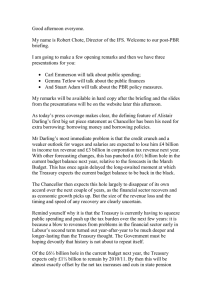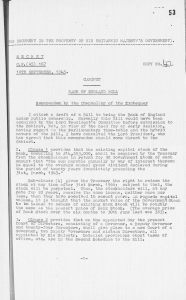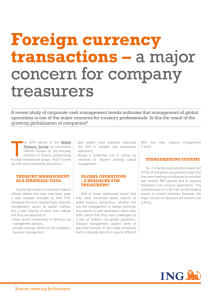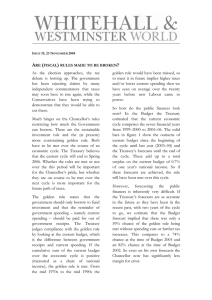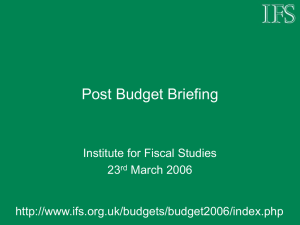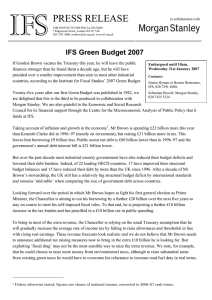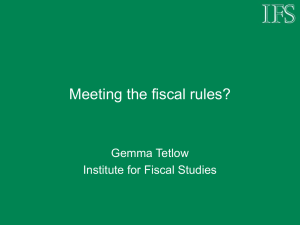Good afternoon everyone. My name is Robert Chote, Director of... Welcome to this, our regular post-Budget briefing. I will make... Post Budget Briefing
advertisement
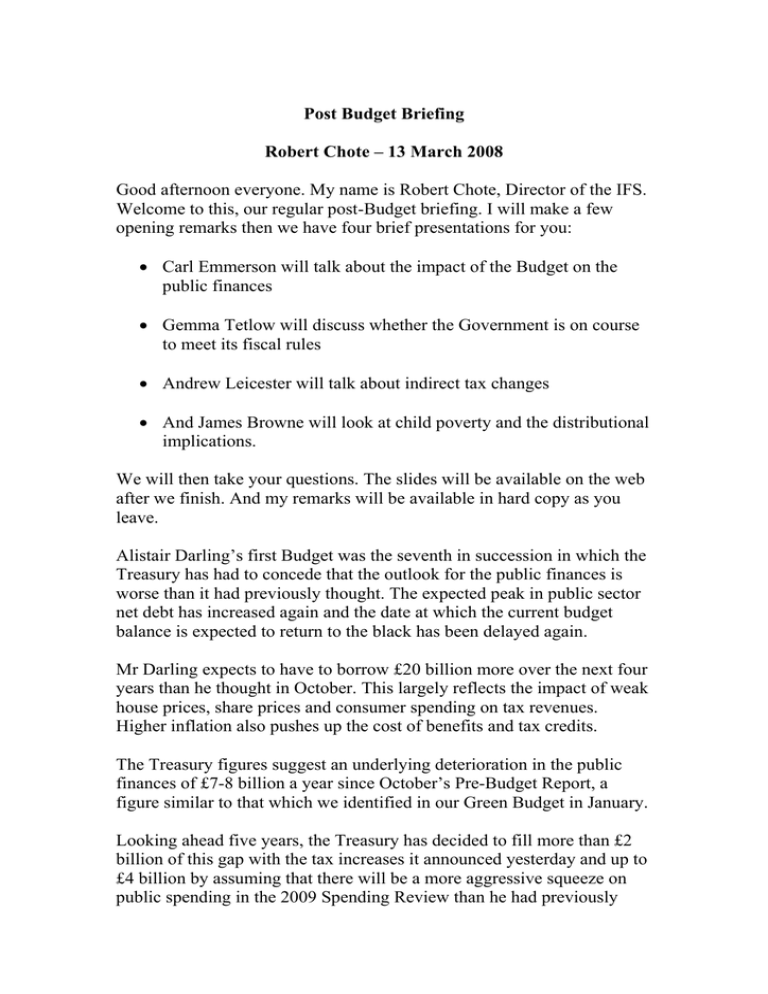
Post Budget Briefing Robert Chote – 13 March 2008 Good afternoon everyone. My name is Robert Chote, Director of the IFS. Welcome to this, our regular post-Budget briefing. I will make a few opening remarks then we have four brief presentations for you: • Carl Emmerson will talk about the impact of the Budget on the public finances • Gemma Tetlow will discuss whether the Government is on course to meet its fiscal rules • Andrew Leicester will talk about indirect tax changes • And James Browne will look at child poverty and the distributional implications. We will then take your questions. The slides will be available on the web after we finish. And my remarks will be available in hard copy as you leave. Alistair Darling’s first Budget was the seventh in succession in which the Treasury has had to concede that the outlook for the public finances is worse than it had previously thought. The expected peak in public sector net debt has increased again and the date at which the current budget balance is expected to return to the black has been delayed again. Mr Darling expects to have to borrow £20 billion more over the next four years than he thought in October. This largely reflects the impact of weak house prices, share prices and consumer spending on tax revenues. Higher inflation also pushes up the cost of benefits and tax credits. The Treasury figures suggest an underlying deterioration in the public finances of £7-8 billion a year since October’s Pre-Budget Report, a figure similar to that which we identified in our Green Budget in January. Looking ahead five years, the Treasury has decided to fill more than £2 billion of this gap with the tax increases it announced yesterday and up to £4 billion by assuming that there will be a more aggressive squeeze on public spending in the 2009 Spending Review than he had previously pencilled in. This still leaves the Treasury looking to borrow slightly more in 2012-13 than it thought in October. This implies an interesting shift in the way in which the Chancellor hopes to reduce government borrowing over the next five years. He gets less help from a rising tax burden, and slightly smaller savings on public spending over the CSR period, than he thought in October. To make the numbers add up he is now looking for a £8 billion spending cut over the two years covered by the 2009 Spending Review – compared to a £4 billion cut over the three years covered by 2007 CSR. The 2009 Spending Review will not of course bite until after the next general election. If things turn out this way, public sector net debt will remain fractionally below the Government’s self-imposed ceiling on public sector net debt. As regular visitors will know, the Golden rule – borrow only to invest – requires the current budget to be in balance or in surplus over the economic cycle. The Treasury has still not decided whether a new cycle got under way in 2006-07 or whether we are still in the cycle that got underway in 1997-98. Either way, to meet the golden rule looking forward requires the cycle to last long enough for the deficits expected this year, next year and in 2009-10 to be offset by later surpluses. Perhaps this is why the Treasury’s economic projections show such a gradual rebound in growth after the slowdown this year, so that the economy does not return to its full potential for a further four years - by which point the cumulative current budget balance would conveniently be back in the black either for a cycle starting in 1997-98 or 2006-07. The significance of the Treasury’s hint that we may still be in the midst of 16 year cycle rather than at the end of a 10 year one will not be lost on the many students of business cycle theory among you. It would suggest that the Treasury is now trying the meet the Golden Rule over a Kuznets cycle rather than a Juglar cycle. The next logical goal would of course be to try to meet it over a Kondratieff Wave, which typically lasts between 45 and 60 years. But I am afraid that by the time we know if they have succeeded, I and perhaps you will long since have stopped caring. So where are the risks to the Treasury’s public finance projections? First, and most obvious, the economic slowdown could be sharper than the Treasury expects – the Budget projections for growth are towards the optimistic end of the independent consensus. Second, tax revenues may be less buoyant over the next five years than the Treasury hopes, even if the downturn is a mild one. For example, the rebound expected in corporation tax revenue may be overoptimistic. Third, the Government may face pressure to extend the various “one off” giveaways it announced in the Budget: the delay to fuel duty increases, the winter allowance for pensioners and the transitional relief for charities. And it will probably need to find another £2-3 billion if it wishes to give itself a reasonable chance of hitting its child poverty target for 2010. All in all, there is danger that we are seeing the history of Labour’s second term repeating itself. As you will recall, Gordon Brown insisted repeatedly after his forecasts began to go awry in 2002 that there was no problem with the public finances – but as soon as the 2005 election was won he announced a spending squeeze and introduced a series of taxraising Budgets and PBRs. If the 2008 Budget was not a good time to deal fully with the underlying weakness of the public finances, it seems unlikely that next year’s will be either. If there is a fiscal repair job to be done, Mr Darling and Mr Brown may be leaving it until after polling day.

